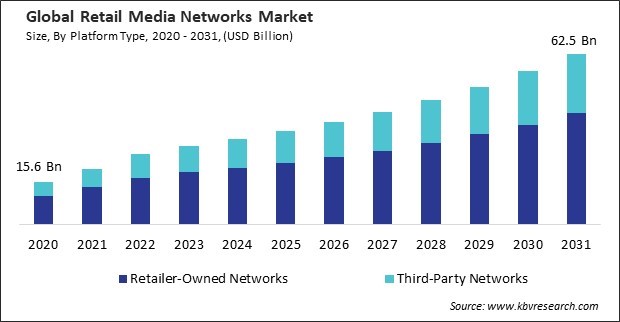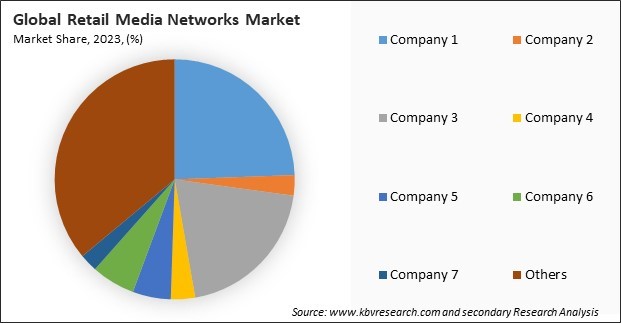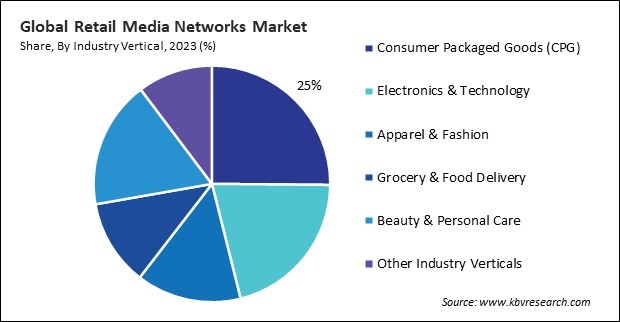“Global Retail Media Networks Market to reach a market value of USD 62.5 Billion by 2031 growing at a CAGR of 10.3%”
The Global Retail Media Networks Market size is expected to reach $62.5 billion by 2031, rising at a market growth of 10.3% CAGR during the forecast period.
In 2023, the Europe region generated 29% revenue share in the retail media networks market. The European market is characterized by diverse consumer preferences and shopping behaviours across various countries, necessitating tailored advertising approaches. Retailers in Europe are increasingly investing in retail media networks to enhance their advertising capabilities, especially as e-commerce grows in popularity.

Retailers are increasingly moving away from traditional advertising methods, such as print and broadcast media, in favour of digital advertising strategies. This shift is primarily driven by the changing preferences of consumers spending more time online. Digital advertising allows for more precise targeting, real-time performance tracking, and interactive engagement, leading to higher conversion rates. In conclusion, retail transformation through digital advertising strategies is driving growth.
Additionally, Consumers today expect shopping experiences to cater to their preferences, needs, and behaviours. This demand for personalization has prompted brands to invest in these networks that allow them to deliver customized advertising and promotional content. By leveraging data analytics and customer insights, retailers can create tailored campaigns that resonate with specific target audiences, enhancing the relevance and effectiveness of their messaging. Thus, growing consumer demand for tailored shopping experiences
As more brands recognize the potential of these networks, the competition for visibility and consumer attention intensifies. An oversaturation of advertising channels can lead to ad fatigue among consumers, making them less responsive to promotional content. In a crowded marketplace, consumers may become overwhelmed by the sheer volume of ads, resulting in decreased engagement and reduced effectiveness of advertising campaigns. In conclusion, high competition and saturation in advertising are impeding the market's growth.

The leading players in the market are competing with diverse innovative offerings to remain competitive in the market. The above illustration shows the percentage of revenue shared by some of the leading companies in the market. The leading players of the market are adopting various strategies in order to cater demand coming from the different industries. The key developmental strategies in the market are Acquisitions, and Partnerships & Collaborations.
Based on platform, this market is divided into retailer-owned networks and third-party networks. The third-party networks segment attained 34% revenue share in the retail media networks market in 2023. Third-party networks act as intermediaries, enabling advertisers to reach consumers across retailers and platforms. While they offer a broader reach and diversification, they may lack the depth of customer insights that retailer-owned networks provide.
By industry vertical, this market is divided into consumer packaged goods (CPG), electronics & technology, apparel & fashion, grocery & food delivery, beauty & personal care, and others. The electronics & technology segment procured 21% revenue share in the retail media networks market in 2023. This segment benefits significantly from the visual nature of retail media, allowing brands to effectively highlight product features, technical specifications, and customer reviews. Consumers in the electronics industry often conduct extensive research before making a purchase, and targeted advertising through retail media can provide them with the necessary information at crucial decision-making moments.

On the basis of advertising format, this market is segmented into display ads, video ads, sponsored industry verticals, and others. In 2023, the sponsored industry verticals segment attained 27% revenue share in the retail media networks market. This segment focuses on specific categories or industries, allowing brands to promote their products in relevant contexts. Sponsored industry verticals enable advertisers to target niche audiences effectively, increasing the likelihood of conversions by presenting products within the framework of specific interests or shopping behaviours.
Free Valuable Insights: Global Retail Media Networks Market size to reach USD 62.5 Billion by 2031
Region-wise, this market is analyzed across North America, Europe, Asia Pacific, and LAMEA. The North America region witnessed 38% revenue share in the retail media networks market in 2023. This dominance can be attributed to the region's mature e-commerce landscape and high digital advertising spending. North American retailers have quickly adopted innovative retail media strategies, leveraging their extensive customer data to deliver highly targeted advertisements.
| Report Attribute | Details |
|---|---|
| Market size value in 2023 | USD 29 Billion |
| Market size forecast in 2031 | USD 62.5 Billion |
| Base Year | 2023 |
| Historical Period | 2020 to 2022 |
| Forecast Period | 2024 to 2031 |
| Revenue Growth Rate | CAGR of 10.3% from 2024 to 2031 |
| Number of Pages | 251 |
| Number of Tables | 380 |
| Report coverage | Market Trends, Revenue Estimation and Forecast, Segmentation Analysis, Regional and Country Breakdown, Market Share Analysis, Porter’s 5 Forces Analysis, Company Profiling, Companies Strategic Developments, SWOT Analysis, Winning Imperatives |
| Segments covered | Platform Type, Advertising Format, Industry Vertical, Region |
| Country scope |
|
| Companies Included | Amazon.com, Inc., Walmart, Inc., , eBay, Inc., , Home Depot, Inc., The Kroger Co. (Kroger Precision Marketing), Instacart, Target Corporation (Target Brands, Inc.), Macy’s, Inc., Best Buy Co., Inc., and Wayfair Inc. |
By Platform Type
By Industry Vertical
By Advertising Format
By Geography
This Market size is expected to reach $62.5 billion by 2031.
Transformation Of Retail Through Digital Advertising Strategies are driving the Market in coming years, however, High Competition And Saturation In The Advertising Space restraints the growth of the Market.
Amazon.com, Inc., Walmart, Inc., , eBay, Inc., , Home Depot, Inc., The Kroger Co. (Kroger Precision Marketing), Instacart, Target Corporation (Target Brands, Inc.), Macy’s, Inc., Best Buy Co., Inc., and Wayfair Inc.
The expected CAGR of this Market is 10.3% from 2024 to 2031.
The Consumer Packaged Goods (CPG) segment captured the maximum revenue in the Market by Industry Vertical in 2023, thereby, achieving a market value of $14.5 billion by 2031.
The North America region dominated the Market by Region in 2023, and would continue to be a dominant market till 2031; thereby, achieving a market value of $23 billion by 2031.
Our team of dedicated experts can provide you with attractive expansion opportunities for your business.

 Drivers
Drivers
 Restraints
Restraints
 Opportunities
Opportunities
 Challenges
Challenges
